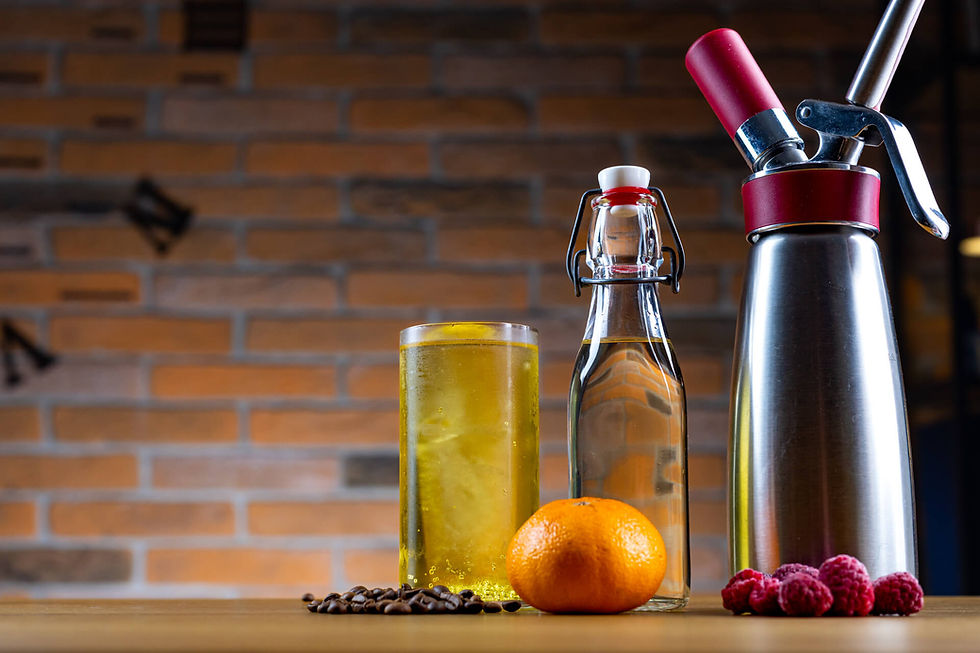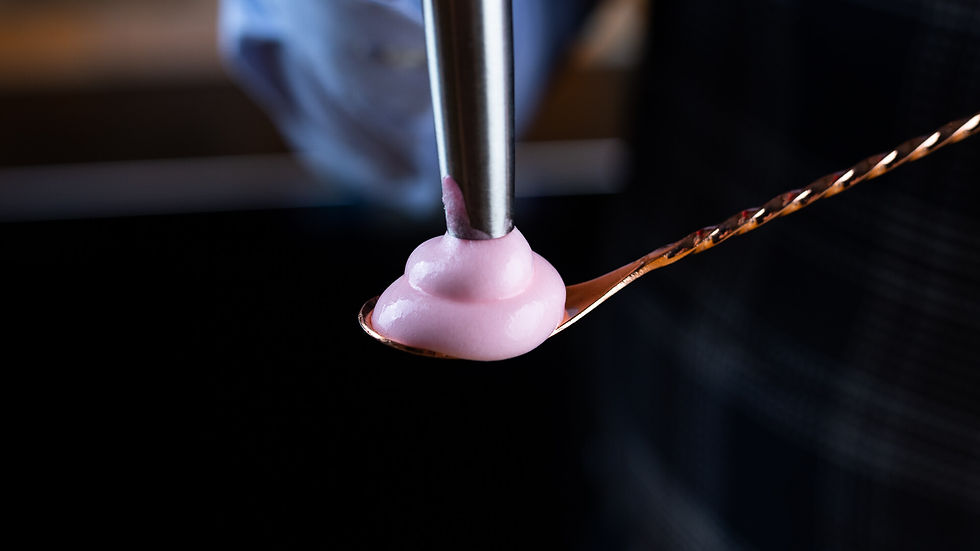Don’t Throw Flat Sparkling Wine Out! Try These Cocktail Ideas Instead
- Kevin Kos
- Apr 29, 2024
- 6 min read

Hi, Friends of Cocktails! Recently we did a list of 20 Useful Cocktail Hacks, but there was something that I wanted to save for an extra episode - what can you do if your sparkling wine goes flat? Well, one surprising answer is Orange Liqueur! To be honest, this scenario is not something that happens often at the Kos household, as my wife and I both love bubbly, but you have to be ready for everything.
We’ll first go over how to prolong the bubbles in an opened bottle, but then I’ll give you a few ideas on how to use up flat sparkling wine for delicious DIY ingredients - but these recipes can work with champagne or other sparkling wines as well, of course. So to begin, what do you do when you have a bottle of sparkling wine open and want to save it for the next day, bubbles and all? Then you need to get a sparkling wine conservator.
These create an airtight seal, and by pumping in air you build up the pressure, keeping the CO2 in the sparkling wine. This preserves the bubbles and the wine's overall freshness, but if you’d like to use flat sparkling wine as a component in your next cocktail instead, there’s a few different ways you can go. The easiest ones are to add sugar or acids.
So turn your wine into a syrup and sweeten any cocktail, with the wine notes adding interesting complexity, or go the other direction and add powdered acids and replace lemon or lime juice with acidified wine, like I did with the Love Road Margarita a few weeks ago. So now that we have our basics covered, let’s look at three more unique ways to use flat sparkling wine in your cocktail: Foam made from rosé sparkling wine, a wine orange liqueur, and a wine coffee cordial.
We’ll work with some Interesting pairings of flavors for a number of cocktails, and I’ll show one for each of these. Now let’s first make Rosé Foam, it’s Cocktail Time!

Rosé Foam
● 250mL · 8.33oz Flat Sparkling Wine
● 20g Raspberries
● 30g Sugar 1 shot Freshly Brewed Espresso
● 1 dash 20% Saline Solution
● 1.35g Methylcellulos
● 0.4g Xanthan Gum
Begin by adding all but the methylcellulose and xanthan gum to a blender, then blend on high speed for about 30 seconds before straining out the solids using a cloth filter. Remember to make sure your sparkling wine is flat for these recipes, as the CO2 would just be in the way for the next steps, so if you’re unsure, whisk it beforehand or stir it using a magnetic stirrer to disperse the bubbles. In the meantime, you can also measure the methylcellulose and xanthan gum.
So now pour the liquid back into the blender and first your powders, blend again to mix and fully dissolve them, and once you’re done we’ll pour this straight into an iSi Siphon. Just like you would for whipped cream, we’re charging this with a N2O charger, shaking the siphon up a bit and placing it in the fridge, since we want the foam to be chilled before use. Try to wait for that before you give it a taste too, so how did it turn out?
The sparkling wine still takes the spotlight here, with raspberry providing a nice color and elevating the berry notes of the base. It's full, creamy, and would go great as a crown on cocktails like a clear Clover Club, or a Cosmopolitan… but I’ll use it in place of egg white foam in a White Lady! Let’s quickly whip it up, before we make our own Wine Orange Liqueur.
White Lady with Rosé Foam
● 45mL · 1.5oz Gin
● 22.5mL · 0.75oz Cointreau
● 22.5mL · 0.75oz Lemon Super Juice
● 1 barspoon Liber & Co’s Gum Syrup
● 2 drops 20% Saline Solution
● Rosé Foam
Into a chilled shaker add all but the Rosé Foam, then add ice, shake hard to chill and dilute, and double strain into a chilled coupe glass. Instead of the classic white foamy crown, this one gets a nice pinkish Rosé Foam topping - beautiful and delicious. Next up, what if you don’t have Cointreau though? Let’s use flat sparkling wine to make a delicious DIY Orange Liqueur - there are many orange liqueurs that are made with grape brandy, so we’re in the same territory.
I’ve yet to make a true DIY Orange Liqueur on the channel, but this will be a fun twist on the classic, that will be a simple and quick process, since we’ll be using essential oils to give us the orange flavor. I’ve talked about sourcing and using essential oils when we made mint liqueur, but really keep in mind to find all natural, food-grade essential oils and follow the recipe to a T, because we’re really talking about concentrated flavors here.
DIY Orange & Wine Liqueur
● 0.38g Orange Essential Oil
● 90mL · 3oz 96% ABV Alcohol
● 240mL · 8oz Flat Sparkling Wine
● 48g Sugar
So let’s start by mixing together exactly 0.38 g of orange essential oil and 90ml of 96% alcohol - a precision scale really is your friend when working with essential oils so that you’re always on the safe side. I’ll leave this to mix together for about 10 minutes, and in the meantime I’ll combine the prosecco and sugar. Now, based on the amount of our sweetened flat sparkling wine we’ll add exactly 34.5 mL of the orange essence. Save the rest for the second batch.
Because we are using essential oils our liqueur will get slightly milky, but there’s no need to worry about it. This is known as the louche effect, and it will clear up in about a week or so, but for now we have a delicious Orange Liqueur with 25% ABV and 150g of sugar per liter. Not as sweet as many other orange liqueurs, but I think it is the sweet spot for DIY liqueurs, and it delivers a wonderful burst of citrus flavor. With the sugar and the wine acidity it’s well balanced, with a refreshing zestiness that lingers.
It’s hard to believe how easy it was to make this DIY liqueur, and it will pair nicely with cognac in a Sidecar cocktail.
Sidecar
● 60mL · 2oz Cognac
● 22.5mL · 0.75oz DIY Orange & Wine Liqueur
● 22.5mL · 0.75oz Lemon Super Juice
● 7.5mL · 0.25oz barspoon Liber & Co’s Gum Syrup
● 2 drops 20% Saline Solution
So again grab a chilled shaker and let’s make it by adding your ingredients along with ice, then shake hard, double strain into a chilled coupe glass, express essential oils from a lemon peel, and place it on the drink - simple, elegant, and wonderful. But I still feel there’s space for another cocktail today, so last but certainly not least, Wine Coffee Cordial, which we’ll use in a highball.
To make it, alongside your opened bottle of sparkling wine, you’ll need some spent coffee, sugar, tartaric acid, and citric acid.
Wine Coffee Cordial
● 20g Spent Coffee
● 107g Sugar
● 250mL · 8.33oz Flat Sparkling Wine
● 4g Tartaric Acid
● 2.75g Citric Acid
The first step is making Coffee Oleo Saccharum, which is inspired by Dan Fellows, whose awesome channel focuses on all things coffee and cocktails. So in a small glass combine your spent coffee with the same weight of sugar, 20g for our case. Mix it together well then leave it to sit for 24 hours. During that time the sugar will pull out the oils and flavors from the ground coffee and we’ll end up with a thick, paste-like mixture of sweet coffee goodness.
We’ll then mix our coffee oleo saccharum with the rest of our ingredients, and once that’s done, it’s time to filter it through a coffee filter. Give it time, but when it’s completely filtered, it’s ready to be used in your next coffee cocktail. Let’s make that a highball I’m calling Gin & Wine & Tonic, with coffee and gentian adding a bit of bitterness instead of quinine.
Gin & Wine & Tonic
● 45mL · 1.5oz Dry Gin
● 30mL · 1oz Wine Coffee Cordial
● 1 barspoon Suze
● 2 drops 20% Saline Solution
● Soda to Top (90g)
Directly into a highball glass filled with ice we’re adding the gin, cordial, Suze and saline solution, then give these ingredients a quick stir to mix and chill a bit. Now place the glass on a scale and top it up with 90 g of soda water. Turn the cocktail gently with a barspoon to mix the ingredients and finish the cocktail with a spray of lemon essential oils, placing the peel on the top. Citrusy, herbal, bitter, sweet, acidic, and refreshing. What more could you ask for?
With that you’ve made it to the Bottom of The Glass or at least the bottom of that opened bottle of sparkling wine. And with all the talk of flat sparkling wine, here’s a fun fact: a scientist, Bill Lembreck, calculated that each bottle of champagne contains 49 million bubbles! So if you still have some sparkling wine that’s carbonated, then check out this playlist for more ideas on how to use it before it goes flat. Cheers, Friends of Cocktails.






Comments